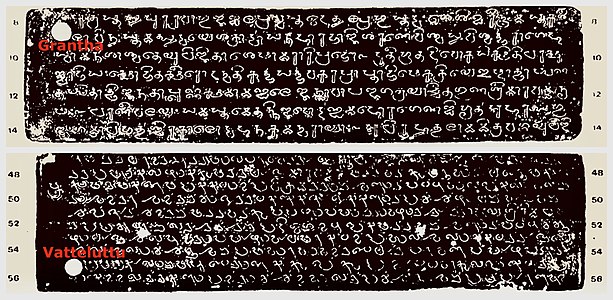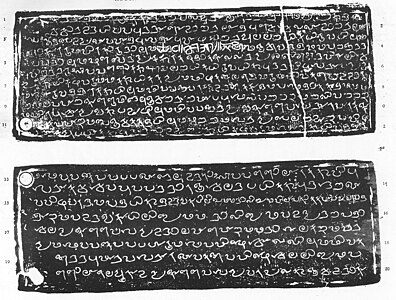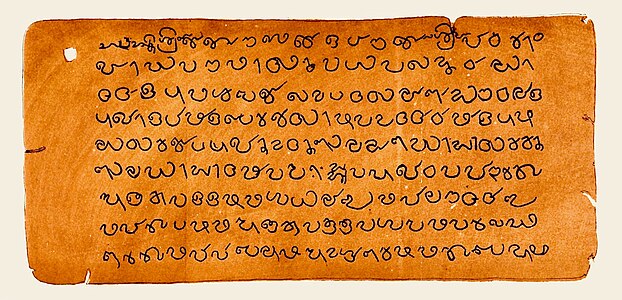Vatteluttu
| Vatteluttu | |
|---|---|
 'Vatteluttu' in modern Vatteluttu typeface[1] | |
| Script type | |
| Direction | Left-to-right |
| Languages | Tamil, Malayalam |
| Related scripts | |
Parent systems | |
Child systems | Koleluttu (script)[3] |
Sister systems | |
[a] The Semitic origin of the Brahmic scripts is not universally agreed upon. | |
| Brahmic scripts |
|---|
| The Brahmic script and its descendants |
Vatteluttu, popularly romanised as Vattezhuthu, (Tamil: வட்டெழுத்து, ISO (IAST: ISO)
and Malayalam: വട്ടെഴുത്ത്,
ISO (IAST: ISO)
, IPA: [ʋɐʈːeɻut̪ːɨ̆]), was a syllabic alphabet of south India (Tamil Nadu and Kerala) and Sri Lanka used for writing the Tamil and Malayalam languages .[4][5]
belonged to the group of Tamil-Malayalam scripts among the Southern Brahmi derivatives.[4][6] The script was used for centuries in inscriptions and manuscripts of south India.[7]
Etymology[edit]
Three possible suggestions for the etymology of the term '' are commonly proposed. Eluttu (ezhuthu) is literally 'written form' in this context; and affixed here it means 'writing system' or 'script'.
The three suggestions are:
- Vatte + eluttu; 'rounded script'[3][5]
- Vata + eluttu; 'northern script'[3]
- Vette + eluttu; 'chiseled script'[3]
The script was also known as Tekken-Malayalam or Nana-mona.[8] The name "Nana-mona" is given to it because, at the time when it is taught, the words "namostu" etc. are begun, which are spelt "nana, mona, ittanna, tuva" (that is, "na, mo and tu"), and the alphabet therefore came to be known as the "nana-mona" alphabet.[8]
History[edit]
probably started developing from Tamil-Brahmi from around 4th-5th century AD.[2][9][10] The earliest forms of the script have been traced to memorial stone inscriptions from the 4th century AD.[2] It is distinctly attested in a number of inscriptions in Tamil Nadu from the 6th century AD.[4] By the 7th to 8th centuries, it had completely evolved from the Tamil Brahmi.[6] Its use is also attested in north-eastern Sri Lankan rock inscriptions, such as those found near Trincomalee, dated c. 5th and 8th centuries AD.[11]
was replaced by the Pallava-Grantha script from the 7th century AD in the Pallava court. From the 11th century AD onwards the Tamil script displaced the Pallava-Grantha as the principle script for writing Tamil.[6][2] In what is now Kerala, continued for a much longer period than in Tamil Nadu by incorporating characters from Pallava-Grantha to represent Sanskrit loan words in early Malayalam.[6][3] Early Malayalam inscriptions (c. 9th and 12th century AD) are composed mostly in .[3][12] The script went on evolving in Kerala during this period and in c. 12th century onwards.[3]
Replacement[edit]
- gradually developed into a script known as "Koleluttu" in Kerala. This script was more commonly used in north Kerala. It continued in use among certain Kerala communities, especially Muslims and Christians, even after the 16th century and up to the 19th century AD.[3]
- Another script derived from was the "Malayayma" or "Malayanma". This script was more commonly used in southern Kerala. The script is not, however, the one that is ancestral to the modern Malayalam script.[7]
- The modern Malayalam script, a modified form of the Pallava-Grantha script, later replaced for writing Malayalam language.[3][7]
Letters[edit]
The script continuously went on evolving during its period of existence (in such a way that the date of a record may be fixed approximately by reference to the script alone).[3][8]
- Last quarter of the 8th century – the difference between two similar letters, such as for instance between 'p' and 'v'; and 'ṅ' and 'l' etc., was very markedly shown.[8]
- A few centuries later – difficult to distinguish between 'k' and 'c', 'ṅ' and 'l', 'p' and 'v' and so on.[8]
- 17th-18 centuries – letters 'p', 'v', 'y', and 'n' and sometimes 'l' also, are alike.[8]
| Vatteluttu | ISO | Equivalent letter in | |
|---|---|---|---|
| Tamil | Malayalam | ||
| a | அ | അ | |
| ā | ஆ | ആ | |
| i | இ | ഇ | |
| u | உ | ഉ | |
| e | எ | എ | |
| Vatteluttu | ISO | Equivalent letter in | |
|---|---|---|---|
| Tamil | Malayalam | ||
| k | க | ക | |
| ṅ | ங | ങ | |
| c | ச | ച | |
| ñ | ஞ | ഞ | |
| ṭ | ட | ട | |
| ṇ | ண | ണ | |
| t | த | ത | |
| n | ந | ന | |
| p | ப | പ | |
| m | ம | മ | |
| Vatteluttu | ISO | Equivalent letter in | |
|---|---|---|---|
| Tamil | Malayalam | ||
| ṟ | ற | റ | |
| y | ய | യ | |
| r | ர | ര | |
| l | ல | ല | |
| ḷ | ள | ള | |
| v | வ | വ | |
Velvikudi Grant (8th century AD, Tamil)
Quilon Plates (9th century AD, Malayalam)
Jewish Plates (11th century AD, Malayalam)
See also[edit]
References[edit]
- ↑ "Vatteluttu". Omniglot.com.
- ↑ 2.0 2.1 2.2 2.3 2.4 Rajan, K. (2001). "Territorial Division as Gleaned from Memorial Stones". East and West. 51 (3/4): 359–367. JSTOR 29757518.
- ↑ 3.0 3.1 3.2 3.3 3.4 3.5 3.6 3.7 3.8 3.9 Narayanan, M. G. S. (2013) [1972]. Perumāḷs of Kerala: Brahmin Oligarchy and Ritual Monarchy. Thrissur (Kerala): CosmoBooks. pp. 379-80 and 398. ISBN 9788188765072.
- ↑ 4.0 4.1 4.2 4.3 Coulmas, Florian (1999). The Blackwell Encyclopedia of Writing Systems. Blackwell Publishing. p. 542. ISBN 9780631214816.
- ↑ 5.0 5.1 Krishnamurti, Bhadriraju. "Tamil Language". Encyclopædia Britannica.
{{cite web}}: CS1 maint: url-status (link) - ↑ 6.0 6.1 6.2 6.3 Krishnamurti, Bhadriraju (2003). The Dravidian Languages. Cambridge University Press. pp. 78, 84–85. ISBN 978-1-139-43533-8.
- ↑ 7.0 7.1 7.2 Freeman, Rich (2003). "The Literary Culture of Premodern Kerala". In Sheldon, Pollock (ed.). Literary Cultures in History. University of California Press. p. 481.
- ↑ 8.0 8.1 8.2 8.3 8.4 8.5 Rao, T. A. Gopinatha. Speciments of Vatteluttu Inscriptions. Travancore Archaeological Series. Vol. XVI (1911 ed.). Government of Travancore. pp. 283–84.
- ↑ Mahadevan, Iravatham (2003). Early Tamil Epigraphy: From the Earliest Times to the Sixth Century AD. Harvard University Press. pp. 210–213. ISBN 978-0-674-01227-1.
- ↑ Salomon, Richard (2004). "Review: Early Tamil Epigraphy: From the Earliest Times to the Sixth Century AD". The Journal of the American Oriental Society. Harvard Oriental Series. 124 (3): 565–569. doi:10.2307/4132283. JSTOR 4132283.
- ↑ Manogaran, Chelvadurai (2000). The Untold Story of Ancient Tamils in Sri Lanka. Chennai: Kumaran Publishers. p. 31.
- ↑ Veluthat, Kesavan. "History and Historiography in Constituting a Region: The Case of Kerala." Studies in People’s History, vol. 5, no. 1, June 2018, pp. 13–31.



